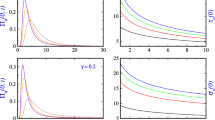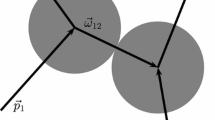Abstract
We re-examine Peres' statement “opposite momenta lead to opposite directions”. It will be shown that Peres' statement is only valid in the large distance or large time limit. In the short distance or short time limit an additional deviation from perfect alignment occurs due to the uncertainty of the location of the source. This error contribution plays a major role in Popper's orginal experimental proposal. Peres' statement applies rather to the phenomenon of optical imaging, which was regarded by him as a verification of his statement. This is because this experiment can in a certain sense be seen as occurring in the large distance limit. We will also reconsider both experiments from the viewpoint of Bohmian mechanics. In Bohmian mechanics particles with perfectly opposite momenta will move in opposite directions. In addition it will prove particularly useful to use Bohmian mechanics because the Bohmian trajectories coincide with the conceptual trajectories drawn by Pittman et al. In this way Bohmian mechanics provides a theoretical basis for these conceptual trajectories.
Similar content being viewed by others
Reference
K. Popper, Naturwissenschaften 22, 807(1934).
K. Popper, Quantum Theory and the Schism in Physics, (Hutchinson, London 1982).
K. Popper in Open Questions in Quantum Physics, Tarozzi G. and A. van der Merwe, eds. (Reidel, Dordrecht 1985),p. 3.
A. Peres, Stud. History Philos. Modern Phys. 33, 23(2002).
M. J. Collett and R. Loudon, Nature 328, 675(1987).
A. J. Short, Found. Phys. Lett. 14, 275(2001).
Y. H. Kim, Y. Shih, Found. Phys. 29, 1849(1999).
T. B. Pittman, Y. H. Shih, D. V. Strekalov and A. V. Sergienko, Phys. Rev. A 52, 3429(1995).
A. Peres, Am. J. Phys. 68, 991(2000).
D. Bohm, Phys. Rev. 85, 166(1952).
D. Bohm, Phys. Rev. 85, 180(1952).
C. M. Caves, Phys. Rev. Lett. 54, 2465(1985).
R. G. Newton, Scattering Theory of Waves and Particles (Springer, New York 1966).
Y. Nogami, F. M. Toyama, and W. van Dijk, Phys. Lett. A 270, 279(2000).
D. DÝrr, S. Goldstein, and N. ZanghÍ, J. Stat. Phys. 67, 843(1992).
P. R. Holland, Phys. Rep. 224, 95(1993).
D. Bohm and B.J. Hiley, The Undivided Universe (Routledge, New York, 1993).
P. N. Kaloyerou, Phys. Rep. 244, 288(1994).
W. Struyve, W. De Baere, J. De Neve, and S. De Weirdt, quant-ph/0311098, Phys. Lett. A. in press.
M. Born and E. Wolf, Principles of Optics (Pergamon, Oxford, 1980).
P. W. Hawkes and E. Kasper, Principles of Electron Optics, Vols. I, II, and III (Academic, London, 1996).
S. A. Khan and R. Jagannathan, Phys. Rev. E 51, 2510(1995).
P. R. Holland, The Quantum Theory of Motion (Cambridge University, Cambridge, 1993).
D. Bohm and B. J. Hiley, Found. Phys. 14, 255(1984).
D. V. Strekalov, A. V. Sergienko, D. N. Klyshko and Y. H. Shih, Phys. Rev. Lett. 74, 3600(1995).
Author information
Authors and Affiliations
Corresponding author
Rights and permissions
About this article
Cite this article
Struyve, W., De Baere, W., De Neve, J. et al. On Peres' Statement “Opposite Momenta Lead to Opposite Directions,” Decaying Systems and Optical Imaging. Foundations of Physics 34, 963–985 (2004). https://doi.org/10.1023/B:FOOP.0000034224.37659.96
Issue Date:
DOI: https://doi.org/10.1023/B:FOOP.0000034224.37659.96




